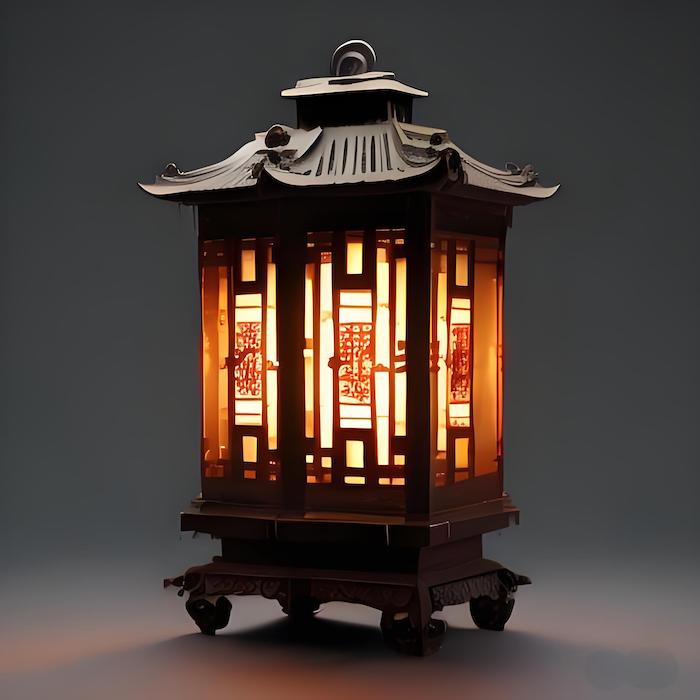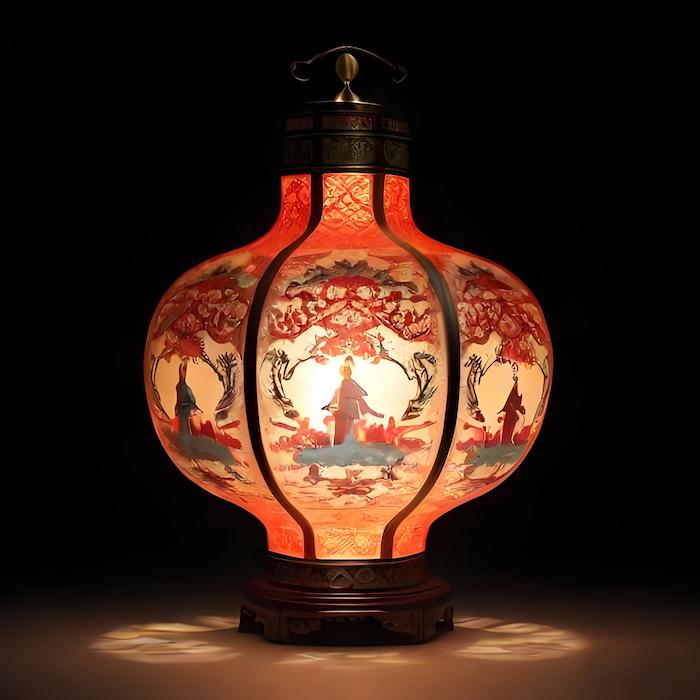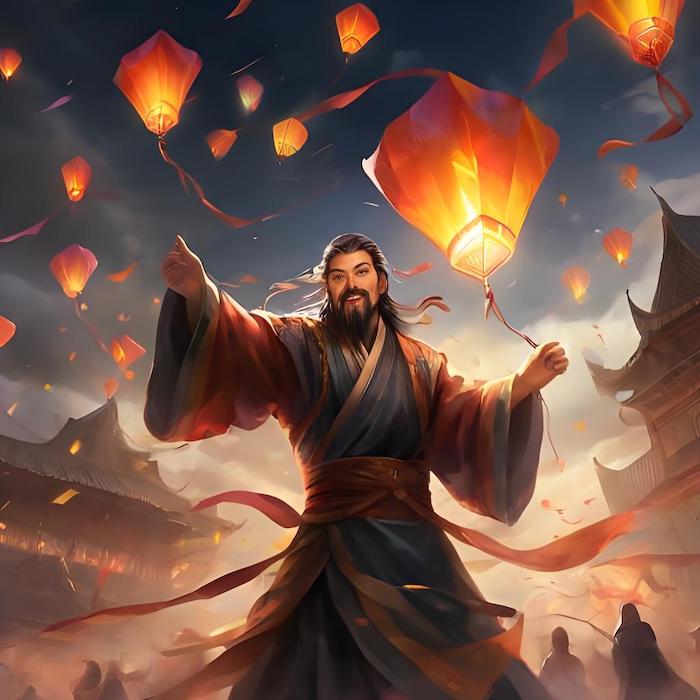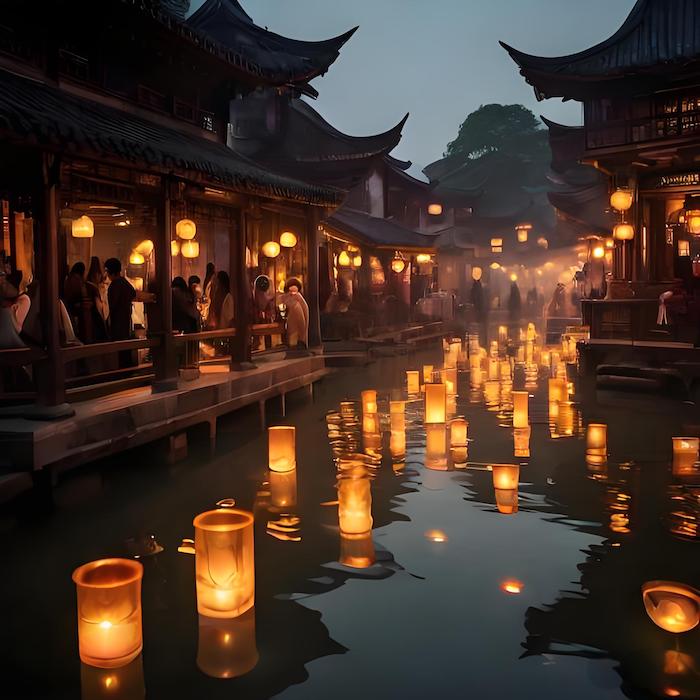As an essential symbol of traditional Chinese culture, lanterns (“denglong”; “灯笼” in Chinese) are renowned for their beautiful shapes and rich colors. They also carry people’s best wishes and deep emotions.
Throughout China’s long history, lantern culture has induced various traditional lanterns with distinctive features, highlighting the wisdom and artistic creativity of the Chinese people. The following six traditional lanterns will demonstrate the extraordinary charm behind lanterns through their unique shapes, exquisite craftsmanship, profound historical origins, and rich cultural connotations.
Table of Contents
- #1 Palace Lanterns (宫灯)
- #2 Yarn Lanterns (纱灯)
- #3 Kongming Lanterns (孔明灯)
- #4 Galloping Lanterns (走马灯)
- #5 Water Lanterns (水灯)
- #6 Red Lanterns (红灯笼)
- Summary
#1 Palace Lanterns (宫灯)
The Splendor of the Court and the Warmth of People

Palace lanterns, also known as imperial lanterns, are known for their magnificent, elegant, and graceful appearance. At first, they were only for the use of the palace aristocracy. Then, they gradually spread to the fork and became the necessary decorations for the Lantern Festival, the Mid-Autumn Festival, and other festivals.
Palace lanterns are of various types, such as the white-hat square lantern, silk round lantern, arhat lantern, and carousel lantern. Different regions have also developed their distinctive styles, such as the delicate craftsmanship of GaoCheng (藁城) palace lanterns, the grandeur of Beijing palace lanterns, and the simplicity of Weifang (潍坊) palace lanterns.
The production process of palace lanterns is highly intricate, involving over fifty steps, each reflecting the effort and wisdom of the craftsmen. The lantern frame is made of wood, with silk or glass panels inlaid on the exterior, and is then adorned with exquisite colorful patterns, showcasing the beauty of handcrafted artistry. The palace lanterns shine like brilliant pearls as night falls, illuminating the festive night sky.
#2 Yarn Lanterns (纱灯)
Lighting up Reunion and Good Fortune

Yarn lanterns are lightweight, translucent gauze lanterns with frames typically constructed from bamboo strips or steel wires. They originated in the Western Han Dynasty and have become an indispensable traditional decoration for Spring and Lantern festivals.
These lanterns come in various shapes, including squares, which symbolize stability; circles, which represent completeness; and rectangles, which represent longevity.
Red is the primary color of yarn lanterns, symbolizing joy and good fortune. Other colors, such as yellow, green, and blue, are also commonly used, each carrying its unique cultural significance.
The craftsmanship of yarn lanterns is intricate, with each step—constructing the frame, covering it with gauze, painting the patterns, and assembling the lantern body—showcasing its distinctiveness. Common motifs on yarn lanterns include flowers, birds, figures, and landscapes, all reflecting the strong Chinese cultural influence.
As the Spring and Lantern Festival approaches, yarn lanterns become key in decorating streets and enhancing the festive atmosphere.
#3 Kongming Lanterns (孔明灯)
Bright Lights for Blessings, Rising Hopes

Kongming lanterns, also known as sky lanterns and prayer lanterns, were invented by Zhuge Liang (诸葛亮) during the Three Kingdoms period. Originally used to convey information and confuse the enemy, they symbolize blessings and remembrance. During festivals such as the Lantern Festival and Mid-Autumn Festival, people light Kongming lanterns and release them into the night sky, signifying happiness and hope.
Kongming lanterns have three parts: the lampshade, the frame, and the fire source. The lampshade is usually made of fireproof paper, bamboo or metal frame, and candles or solid fuels provide the fire source. As Kongming lanterns slowly rise, the bright lights flicker in the night sky like a good wish flying to distant places.
#4 Galloping Lanterns (走马灯)
Spinning Scrolls, Dynamic Art

The Galloping Lantern is famous for its unique rotating feature. Its name comes from the dynamic changes in its internal patterns, which resemble galloping horses running inside the lantern. This offers a lively visual experience.
The intricate structure of a lantern typically consists of three parts: the lampshade, the frame, and the internal mechanism.
The lampshade is usually made from transparent materials such as glass or paper, allowing the internal patterns to be visible as they change. Because of their strong craftsmanship, paper lanterns have gained the favor of many Chinese people.
The frame supports the entire lantern, ensuring it remains stable whether suspended in the air or placed on the ground.
The most remarkable feature is the internal mechanism. It operates on the principle of rising warm air: lighting a candle or heating a metal strip inside the lantern generates hot air that drives a rotating spindle. The spindle is connected to several fan blades or paper strips adorned with patterns. As it turns, these patterns create a continuously changing effect inside the lampshade, such as galloping horses, blooming flowers, or scenes from mythical tales coming to life.
#5 Water Lanterns (水灯)
Floating Prayers and Solace for the Soul

Water lanterns float on water, also known as river and lake lanterns. They originated in India, and after Buddhism was introduced to China, they gradually developed into a traditional ritual for worshipping deities, dispelling misfortune, and commemorating the deceased. Water lanterns are made from various materials, including flowers, leaves, and paper. They come in multiple shapes, such as lotus flowers, lamps, and dragons, each with different symbolic meanings.
During festivals such as the Mid-Yuan Festival and other folk celebrations, people release water lanterns into rivers, lakes, and seas as an offering of remembrance for the deceased and prayers for a hopeful future. The custom of water lanterns is popular in China. It is essential in Southeast Asian countries, such as Thailand’s Loi Krathong Festival, reflecting cross-cultural heritage and exchange.
#6 Red Lanterns (红灯笼)
Bright, Festive, and a Reflection of Traditional Culture

With their vivid red color and unique shape, red lanterns have become a striking symbol of traditional Chinese culture. In Chinese culture, red represents passion, good fortune, and prosperity, while lanterns signify reunion, light, and hope. Red lanterns are hung in homes during the Spring and Lantern Festival, creating a festive atmosphere.
The craftsmanship of red lanterns is meticulous. They typically use bamboo poles or iron wire as the frame, which are covered with red paper or silk and adorned with beautiful patterns and decorations. These patterns often draw from myths, legends, historical stories, and auspicious symbols, such as the dragon and phoenix, or themes of abundance and good harvests. They not only showcase the artistry of the artisans but also convey people’s hopes and wishes for a better life.
Beyond their decorative function, red lanterns carry profound cultural significance. They symbolize family warmth and reunion, the prosperity of one’s career, and the beauty of life. In rural areas, red lanterns are often hung outside homes or under eaves, adding warmth and tranquility to the night; in cities, they line streets, infusing the urban environment with joy and vitality.
Red lanterns are also deeply tied to traditional Chinese festivals and customs. During the Spring Festival, red lanterns are displayed to welcome the New Year; during the Lantern Festival, people carry lanterns, admire the displays, solve riddles, and celebrate the season’s joy. These traditions enrich people’s cultural lives and preserve the profound heritage of Chinese culture.
Summary
From the majestic palace lanterns to the delicate and lightweight silk lanterns, from the Kongming lanterns carrying wishes and dreams to the playful galloping lanterns to the water lanterns filled with deep emotion and profound meaning, and the red lanterns symbolizing celebration and prosperity—each lantern embodies rich cultural heritage and strong emotional significance.
Lanterns are not just lighting tools but symbols filled with deep cultural meaning. They transcend history and modernity, connecting the past and the future, expressing people’s endless yearning and pursuit of a better life. In the joy of festivals and the depths of the soul, Chinese lanterns, with their unique glow, illuminate people’s smiles and dreams.
